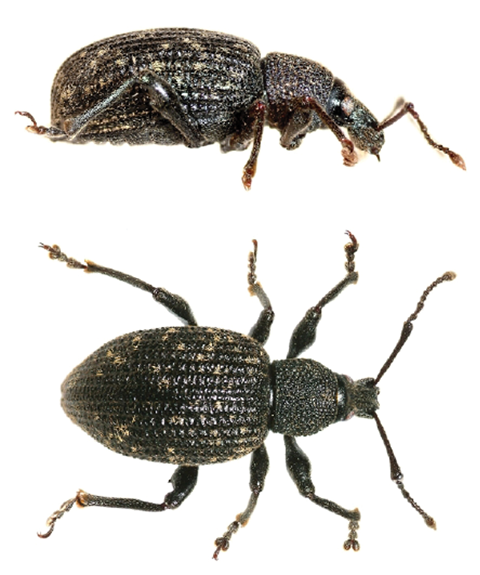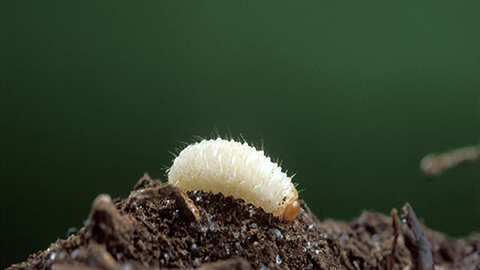Integrated Pest Management
Root Weevils
 Adult black vine weevil (Kent Loeffler, Cornell University, Bugwood.org)
Adult black vine weevil (Kent Loeffler, Cornell University, Bugwood.org)
 Black vine weevil larvae (Peggy Greb, USDA ARS, Bugwood.org)
Black vine weevil larvae (Peggy Greb, USDA ARS, Bugwood.org)
HOSTS
- Lilac
- Strawberry
- Raspberry
- Privet
- Spruce
- Rose
- Grape
DESCRIPTION
Root weevils are occasional nuisance pests indoors mid-summer through fall. Root weevils are small beetles ranging in length from about 1/4 to 1/3 inch depending on species. Coloration is variable, but the commonly encountered species in Utah are black with gold flecks (black vine weevil) or solid brown to black, shiny or matte.
BIOLOGY
Root weevils have one generation per year. While some adults may overwinter, the majority of the population overwinters as larvae in the soil around host plants. When soil temperatures warm in the spring, larval feeding resumes and larvae continue to grow until they pupate in late May or early June. Adults emerge around mid-June and begin feeding. By late June and early July, adults begin laying eggs in the soil around host plants, which will hatch into the larvae that eventually overwinter.
SYMPTOMS
- Marginal leaf notching
- Canopy decline
GENERAL MANAGEMENT
Management of root weevils is focused primarily on larvae in the soil and adults on the host plant or hiding on the ground near the base of the plant.
To manage adult weevils begin monitoring for marginal leaf notching in June. Adults can be found on the plant at night, using a flashlight, or during the day by searching in the soil, mulch, ground cover, etc., in vicinity of the plant stem.
INSECTICIDES
Larvae in the soil can be targeted April through September with a systemic insecticide (Imidacloprid) applied within the host plant root zone.
Pyrethroids (beta-cyfluthrin, bifenthrin, cyfluthrin, permetrin, etc.) applied to the foliage where adults feed, to the stem where they travel, or to the ground around the stem where weevils hide during the day can effectively control adults.

